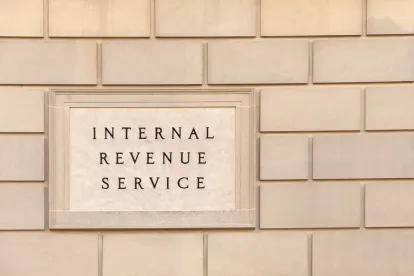Background
As discussed in our prior client alert, new Internal Revenue Code Section 4960 (“Section 4960”) imposes a 21 percent excise tax on “excess remuneration” and “excess parachute payments” paid by an organization that is exempt from tax under section 501(a) of the Code to certain “covered employees” during a taxable year. Section 4960 applies for taxable years beginning after December 31, 2017—for employers on a calendar year tax year, this means Section 4960 took effect with respect to amounts paid in 2018. As the deadline to report and pay the excise tax approaches (May 15, 2019, is the deadline for calendar year taxpayers), tax-exempt employers have questions about how Section 4960 is meant to be applied. IRS Notice 2019-09 (the “Notice”), published at the start of 2019, provides guidance on the application of Section 4960 and sheds light on, among other things, (i) what an applicable tax-exempt employer is, (ii) who a covered employee is, (iii) what constitutes excess remuneration and excess parachute payments, and (iv) how to report and pay the excise tax. Until the Treasury Department and IRS issue regulations implementing Section 4960, the Notice describes “a good-faith, reasonable interpretation of [S]ection 4960” on which taxpayers may rely.1
Getting Ready for May 15, 2019 (for ATEOs whose taxable year is the calendar year)
For tax-exempt employers that are looking toward May 15, 2019, and wondering how Section 4960 will affect them, we’ve outlined several steps that an employer may want to take now to prepare. This article is the third in a series of alerts providing additional detail about certain key concepts in the Notice that may help guide an employer’s analysis.
- Determine if your organization is an applicable tax-exempt employer (“ATEO”) subject to Section 4960. The definition of ATEO is discussed in Part I of this Client Alert Series.
- Identify any related organizations that will need to be taken into account to compile the ATEO’s list of covered employees and to determine the total remuneration paid and excess parachute payments made to covered employees. The related organization rulesare discussed in Part I of this Client Alert Series.
- Compile the list of covered employees. To prepare the initial list, an ATEO will need to identify both covered employees for 2018 and covered employees for 2017 (i.e., an ATEO may have more than five covered employees on its initial list). Identification of covered employees for 2017 is necessary due to the “once a covered employee, always a covered employee” rule (i.e., if an employee is a covered employee for a taxable year beginning after December 31, 2016, he or she will always be a covered employee for purposes of Section 4960). Remuneration from related employers needs to be taken into account for this purpose, so ATEOs will need to obtain compensation data from all related organizations. The definition of covered employee and the definition of remuneration are discussed in Part II of this Client Alert Series.
- Determine if any covered employee received excess remuneration during 2018. The rules for determining excess remuneration are discussed in Part II of this Client Alert Series.
- Determine if any covered employee received an excess parachute payment during 2018. The rules for identifying and quantifying the value of excess parachute payments are discussed below.
- If excess remuneration was paid and/or excess parachute payments were made to any covered employee in 2018, calculate the amount of excise tax owed by the ATEO and each related organization. The rules for calculating the excise tax and apportioning liability among related organizations are discussed below.
- File Form 4720 to report and pay the excise tax. The filing requirements for Form 4720 are discussed below..
Excess Remuneration
For each covered employee, remuneration in excess of $1 million for the taxable year paid by an ATEO (including by a related organization) is considered excess remuneration that triggers the Section 4960 excise tax. Remuneration paid by another organization, whether or not a related organization, with respect to the covered employee’s employment by an ATEO, is considered remuneration paid by that ATEO. If an ATEO includes remuneration from one or more related organizations in determining the excise tax owed, each organization is liable for a pro-rata share of the excise tax based on the amount of remuneration paid by the organization in relation to the total amount of remuneration paid by the ATEO and all related organizations.
Example: F and G are each ATEOs and G is a related organization with respect to F. E is a covered employee of both F and G. F pays E $1.2 million of remuneration, and G pays E $800,000 of remuneration for a total of $2 million of remuneration, and $1 million of excess remuneration. The total excise tax is $210,000 (21% of the $1 million in excess remuneration). F paid 3/5 of E’s total remuneration ($1.2 million /$2 million) so it is liable for 3/5 of the excise tax ($126,000) and G is liable for 2/5 of the excise tax ($84,000).
Excess Parachute Payments
In General
The excess parachute payment rules under Section 4960 are modeled after the golden parachute rules that apply to for-profit entities under section 280G of the Code. As noted above, these rules result in a 21% excise tax on any excess parachute payments paid by an ATEO (or a related organization) to any covered employee. An excess parachute payment is an amount equal to the excess of the total amount of any parachute payment made by an ATEO (or related organization) over the portion of the employee’s base amount that is allocated to the payment. The portion of the base amount allocated to any parachute payment is determined by multiplying the base amount by a fraction, the numerator of which is the present value of the parachute payment and the denominator of which is the aggregate present value of all parachute payments.
Example: E is a covered employee of ATEO X and an employee of related organization Y. E’s base amount is $200,000 with respect to X and $400,000 with respect to Y (total base amount of $600,000). E receives $1 million from X and $1 million from Y contingent upon E’s involuntary termination of employment from X and from Y. The two payments are parachute payments because their aggregate present value is at least three times E’s base amount (3 x $600,000 = $1.8 million). The portion of the base amount allocated to each parachute payment is $300,000 (($1 million / $2 million) x $600,000) so the amount of each excess parachute payment is $700,000 ($1 million – $300,000).
Parachute Payments
A parachute payment includes any payments in the nature of compensation made by an ATEO (or a related organization) to, or for the benefit of, a covered employee (i) that are contingent on the employee’s termination of employment, and (ii) the aggregate present value of which equals or exceeds three times the employee’s base amount, which is generally the average annual compensation paid to the employee for services performed for the ATEO or for a related organization (with respect to which there has been a termination of employment) for the five most recent calendar years ending before the employee’s termination date. Certain payments are excluded from the definition of parachute payments, including payments under qualified plans, 403(b) plans, or 457(b) plans, payments made to licensed medical professionals for the performance of medical or veterinary services, and payments made to non-highly-compensated employees. A “highly compensated employee” for this purpose is generally defined as any employee who was a five-percent owner at any time during the year or during the preceding year or who had compensation from the employer in the preceding year in excess of an inflation-adjusted amount ($120,000 for 2018 and $125,000 for 2019).
Payments in the Nature of Compensation
A payment in the nature of compensation is any payment that arises out of an employment relationship and includes but is not limited to (i) salary, bonus, severance pay (including payments under a window program), fringe benefits, life insurance, and deferred compensation payments; (ii) payments under a noncompete arrangement; and (iii) the value of accelerated vesting. In general, a payment in the nature of compensation is considered made in the taxable year in which the payment is includible in income or, in the case of benefits that are excludible from income, in the taxable year in which the benefits are received. Thus, transfers of property (such as restricted stock) will generally be considered made at the later of the date the property is transferred or the date the property becomes vested (and without regard to an 83(b) election that might have been made by the employee). However, stock options and stock appreciation rights are considered paid upon vesting.
Contingent on Termination of Employment
A payment is contingent on an employee’s termination of employment if the facts and circumstances indicate that the payment would not have been made but for an involuntary termination of employment (which may include the nonrenewal of an employment contract). Any compensation and/or equity rights that are vested or that were otherwise included in gross income before a termination of employment are not considered contingent on a termination of employment. However, a payment does not fail to be contingent on termination of employment merely because the payment is conditioned upon the execution of a claims release requirement or other restrictive covenants, such as a noncompete or nondisclosure requirements. In addition, payments under a window program, such as an early retirement program, will generally be treated as contingent on a termination of employment.
Termination of employment generally has the same meaning as “separation from service” for 409A purposes. However, the definition of termination of employment under Code Section 4960 differs from the 409A definition in certain respects, such as (i) a change in status from employee to consultant is considered a termination of employment, (ii) the ATEO may not set the level of the anticipated reduction in future services that will give rise to a termination of employment (default rules in 409A regulations will apply), and (iii) the control threshold for purposes of determining whether an employee terminates employment with the ATEO and all entities that would be considered a single employer for purposes of sections 414(b) and (c) of the Code is set at 80% (instead of 50%).
Since parachute payments must be contingent on an involuntary termination of employment, payments made in connection with a voluntary termination of employment (such as payments conditioned upon compliance with restrictive covenants after a voluntary termination) will not be taken into consideration for the excess parachute payment rules.
Special Rules for Accelerated Payments and Accelerated Vesting
If a payment is accelerated upon a termination of employment, only the value due to the acceleration is treated as contingent on termination of employment. In general, the value of the acceleration is determined as the amount by which the present value of the accelerated payment exceeds the present value of the payment absent the acceleration. In the case of nonvested payments that are subject to a vesting service condition, the portion of the payment that is contingent on a separation from service is the value of the acceleration of the payment plus the value of the lapse of obligation to continue to provide services. In the case of nonvested payments that are subject to a vesting condition other than a service condition, the full amount of the accelerated payment is treated as contingent on termination of employment.
Excise Tax2
The common-law employer (as determined for federal tax purposes) of a covered employee is liable for the 4960 excise tax. Only an ATEO has covered employees, but a covered employee may also be an employee of a related organization. When an employer that is an ATEO or related organization pays a covered employee either excess remuneration or an excess parachute payment, each employer is liable for a proportionate share of the 4960 excise tax.
The excise tax is reported on Form 4720 (Return of Certain Excise Taxes under Chapters 41 and 42 of the Internal Revenue Code). The deadline for filing Form 4720 is the 15th day of the 5th month after the end of the employer’s taxable year (May 15 for employers with a calendar year tax year). Although an ATEO may obtain an extension to file the Form 4720, the extension will not apply to the deadline for paying the Section 4960 excise tax, and penalties and interest for late payment may be assessed for any Section 4960 excise tax that is paid after the original due date of Form 4720. There is no requirement to pay estimated taxes on excise taxes imposed under Section 4960. The excise tax requirement is in effect for remuneration that is paid for the first taxable year that begins after December 31, 2017.
1 The Notice also notes certain positions that are not a good-faith, reasonable interpretation of Section 4960 (for example, it is not reasonable for an employer to take the position that an individual ceases to be a covered employee after a certain period of time).
2 The imposition of an excise tax under Section 4960 is not determinative of whether remuneration paid to a covered employee is excess or unreasonable compensation for purposes of section 4958 of the Code or whether the remuneration paid to the covered employee is excessive or unreasonable compensation for purposes of section 4941 of the Code.






 />i
/>i
